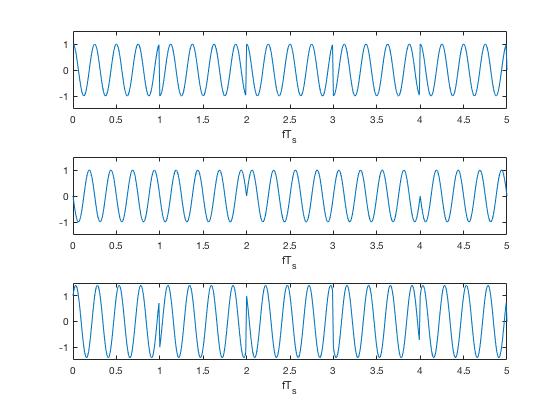t=0:0.01:5; fc=4; % c=length(t); pRec=ones(1,(length(t)-1)/5); % 1-100 sI=zeros(1,length(t)); sQ=zeros(1,length(t)); % 500 zeros dataI=[1 -1 1 -1 1]; indPulse=1:(length(t)-1)/5; % 1-100 % c1=length(dataI); for i=1:length(dataI) % 5 waveforms sI(indPulse)=dataI(i)*pRec; indPulse=indPulse+length(indPulse); end; dataQ=[-1 -1 1 1 -1]; indPulse=1:(length(t)-1)/5; % After dataI indPulse has changed so define it 1-100 again % c1=length(dataI); for i=1:length(dataQ) % 5 waveforms sQ(indPulse)=dataQ(i)*pRec; indPulse=indPulse+length(indPulse); end; sCarI=cos(2*pi*t*fc); sCarQ=sin(2*pi*t*fc); figure(1); subplot(3,1,1); plot(t,sI.*sCarI); set(gca, 'Ylim',[-1.5 1.5]); xlabel('fT_s'); subplot(3,1,2); plot(t,sQ.*sCarQ); set(gca, 'Ylim',[-1.5 1.5]); xlabel('fT_s'); subplot(3,1,3); plot(t,sI.*sCarI-sQ.*sCarQ); set(gca, 'Ylim',[-1.5 1.5]); xlabel('fT_s');
figure1: xI(t)cos(2*pi*fc*t)
figure2: xQ(t)sin(2*pi*fc*t)
figure3: xI(t)cos(2*pi*fc*t)-xQ(t)sin(2*pi*fc*t)
